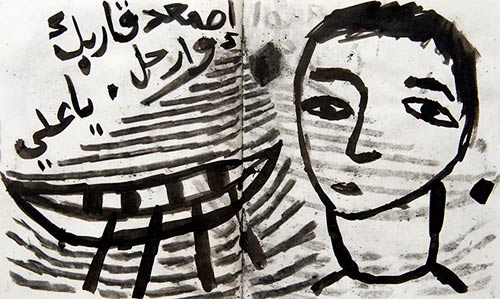The Asahi Shimbun Displays - Moving stories
Free - Room 3
Humanity has moved across the globe for a million years and more. Its footprint is ever changing. There are many reasons why humans leave their homes – war and conflict, famine and death, love and hope. But in those circumstances, what do you gain? What do you leave behind?
Human migration is complex, powerful and emotive. In the light of the recent media coverage, this display focuses on just a few of these journeys – a million-year-old story told in footprints discovered at Happisburgh in Norfolk, an emotional story of exile by Iraqi artist Sadik Kwaish Alfraji, and a more abstract journey told by poet and philosopher Édouard Glissant.

Sadik Kwaish Alfraji (b. 1960), a page from Ali’s Boat 1. Indian ink and charcoal on notebook paper, 2014. © Sadik Kwaish Alfraji. Reproduced by permission of the artist.
The Happisburgh footprints were discovered by fieldwork organised by the British Museum in 2013. They survived for only two weeks before being eroded by the sea. In the display, you can see them as a projected animation, made from a 3D model of the surface. The footsteps show a family group of hominids walking and pausing on the muddy edge of a large estuary. At this time, Britain was still physically joined to the European continent and fauna would have included red deer, horses, giant elk, rhinoceroses and mammoths. At almost a million years old, the footprints are the earliest evidence of humans in northern Europe. They pose questions about how our ancestors coped with the long, cold winters and competed for game with carnivores like hyenas and sabre-toothed cats. Journeys like this eventually led to adaptation to more difficult environments through better provision of basic human needs – food, clothing, shelter and fire.
Today humans still have the same needs, but different boundaries. Ali’s Boat is an artist’s book by Sadik Kwaish Alfraji (b. 1960) who left Iraq in 1991. Made in 2014, it acts as a meditation on the nature of exile. It is inspired by the artist’s encounter with his 11-year-old nephew who, on a visit to Baghdad in 2009, gave Alfraji a drawing of a boat, with the words ‘I wish this boat takes me to you.’ The book warns of the difficulty of the journey and merges into the artist’s own predicament as an exile.
These two journeys are framed by a third, which takes the form of a film featuring poet and philosopher Édouard Glissant (1928–2011) directed by Manthia Diawara. Glissant reflects on the devastating impacts of slavery, colonialism and racism on Caribbean culture. Despite everything, his ideas offer a positive outlook on the potential of migration to benefit humanity on a global scale. Although a migrant may lose the social and cultural ‘unity’ of their place of origin, they gain a cultural diversity or ‘multiplicity’. He explores how differences do not divide us but rather can co-exist with what we share and hold dear, in order to create stronger, global communities.
The show provides space to reflect on the similarities and differences between epic and transformative journeys – sometimes separated by millions of years but connected by our shared humanity.